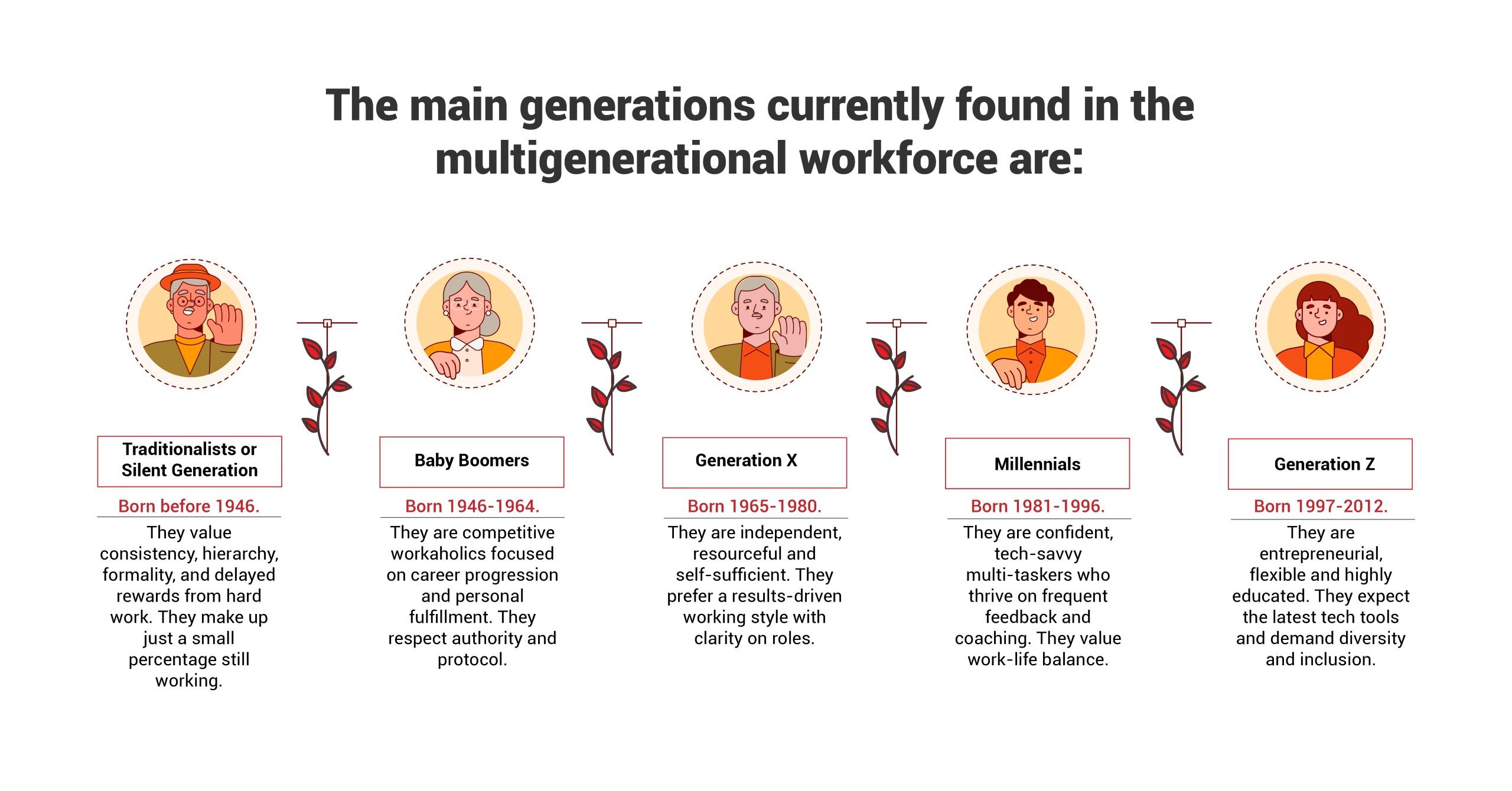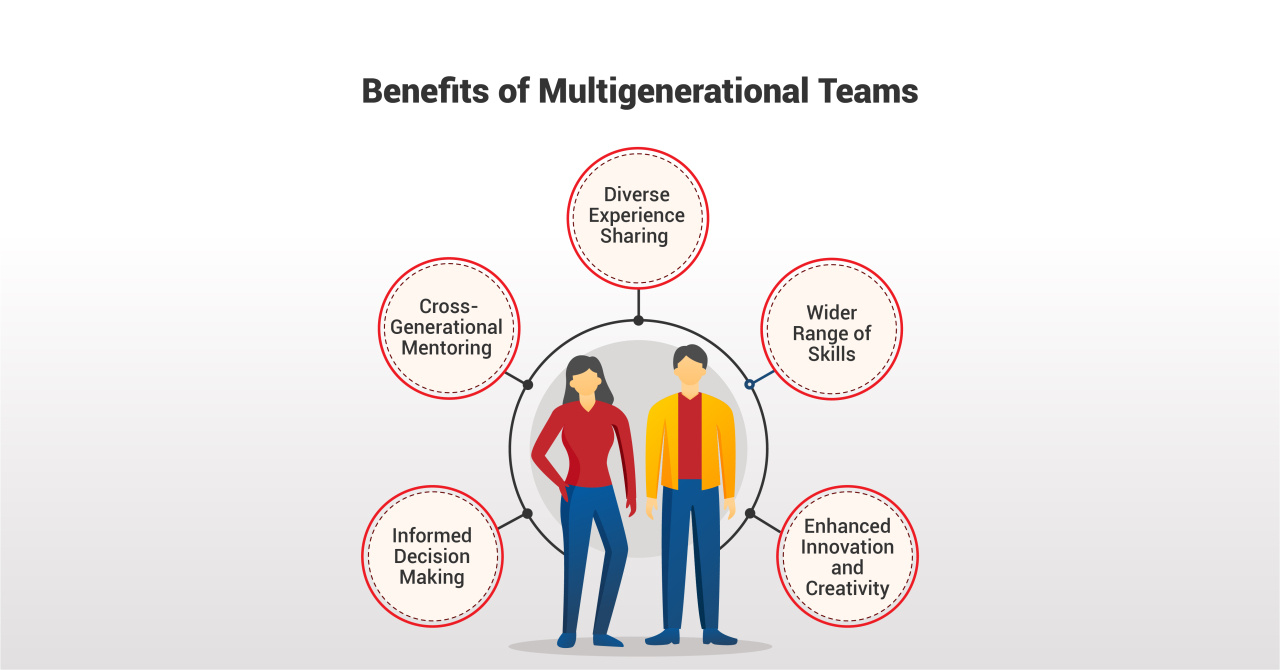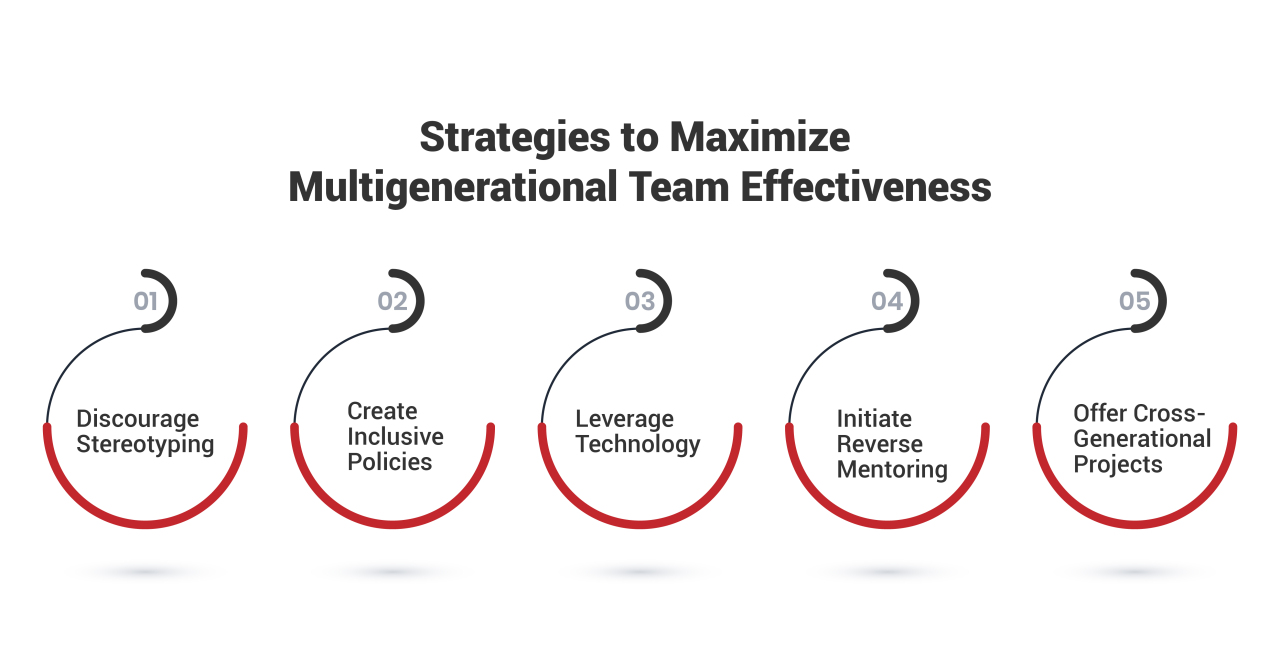A multigenerational workforce comprises employees from different age groups, including Baby Boomers, Generation X, Millennials, and Generation Z. While having multiple generations working together has its challenges, the diversity in perspectives and experiences also brings several advantages. HR leaders and team managers can implement various strategies to maximize the benefits and overcome the drawbacks of a multigenerational workforce.
As life expectancy has increased and people work later into life, for the first time we have up to 4 or 5 generations coexisting in the workforce - Traditionalists, Baby Boomers, Generation X, Millennials, and Generation Z. Having such a diverse mix of ages brings unique benefits as well as some challenges that organizations need to manage.
Multigenerational teams have the following key advantages:
A multigenerational workforce comprises employees from different age groups, often spanning three to four generations working together. This includes Baby Boomers, Generation X, Millennials, and the emerging Generation Z. Each generation brings its own distinct set of experiences and ideas to the workplace.
Baby Boomers have been working the longest and have accumulated decades of experience over their careers. They possess rich institutional knowledge from having been with organizations for extended periods. Their long tenures have provided them opportunities to develop deep expertise in various domains. Baby Boomers contribute immense wisdom gathered from rising up the ranks to leadership roles and managing businesses over the years.
At the same time, Millennials and Gen Z workers, having grown up in a rapidly evolving digital era, bring newer perspectives. They have been educated and trained differently from previous generations, with greater emphasis on leveraging technologies. These younger employees play an invaluable role in helping companies keep pace with changing consumer preferences and market dynamics.
With such diversity of experiences, multigenerational teams benefit greatly from knowledge sharing across generations. Baby Boomers pass down know-how, methodologies, and life lessons that they have gained over time. The rich insights they provide are a tremendous value-add that may not be easy to find elsewhere. Reciprocally, younger employees educate older ones on newer ways of thinking, emerging skills like advanced data analytics, and recent technological developments relevant to the business.
This symbiotic, bi-directional learning expands overall organizational knowledge. With time and collaboration, the diverse experiences become collective wisdom that multigenerational teams can apply to drive innovation and gain competitive advantage. Institutional memory gets preserved, while new information keeps flowing in - achieving that optimal balance of the old and new.
Spanning multiple generations, as noted earlier, brings senior employees with varied backgrounds and skill sets together. Seasoned Baby Boomer professionals and managers possess finely honed soft skills. Having dealt with pre-digital era work complexities, they have exceptional organizational and people management abilities. Years spent collaborating with business partners and customers have also made them master relationship-builders and negotiators.
On the flip side, Millennials and Gen Z employees help fill any technology skill gaps that organizations or older employees may face. Having grown up in a highly digital environment, these young adults display greater adaptability in learning new technologies. Their innate familiarity of technology allows them to pick up digital capabilities like data analytics rapidly. With many among them being sophisticated social media users, they can infuse marketing teams with the latest know-how to engage connected customers.
Thus, a multigenerational workforce has all bases covered on the skills front. It stands to benefit from technical and soft skills alike to handle a wide variety of challenges and address complex, ever-evolving business needs. Teams can have specialized experts passing the baton to willing learners in a well-rounded environment of skill-sharing and growth.
The convergence of diverse experiences and skills makes multigenerational teams hotbeds for innovation. Having employees with distinct generational perspectives provides unique, multifaceted inputs. Baby Boomer specialists can leverage their institutional knowledge and vast networks to provide insights based on years of observations and industry immersion. Millennial employees’ understanding of new-age customer expectations and Gen Z’s intuitive grasp of youth preferences can add additional dimensions.
Such multi-faceted, even contrarian thinking provides fertile ground for ideas to breed and creative concepts to emerge. When teams have employees who approach problem-solving from different experiences and analytical methods, it shakes things up nicely. Long-held industry assumptions are challenged in the process. Outcome-bias and status quo adherence reduce, allowing teams to openly explore new spaces with beginner minds. The rich backdrop of context and expertise makes ideation more rounded. It brings shelf-ready wisdom as input while allowing thinking unconstrained by regimented pathways. That is why innovation thrives in such environments of diversity and free flow of perspectives.
Moreover, innovation itself becomes a comprehensive process encompassing multiple generational vantage points. This ensures ideas and solutions appeal to and work for a wider demographic range - an invaluable competitive differentiator. For instance, products co-created by Baby Boomers, Gen X and Millennials together have a better chance of appealing to those very demographics based on the deep consumer insights.
Multigenerational teams make more balanced decisions owing to the availability of diverse views during deliberations. Critical judgments based purely on the opinions of one generation run the risk of reflecting strong biases. Limited diversity hampers the decision-making process from exploring all pertinent aspects. Having singular minds or homogeneous generational perspectives heightens subjectivity risks and echo chamber effects.
Counterbalancing with a wider generational spread minimizes such myopia during collaborative decision making. Baby Boomers in leadership roles bring a broad vision based on decades of experience with macro trends and economic cycles. Millennial employees ensure key consumer preferences and digital-first expectations get a voice at the table. And emerging Gen Z stalwarts highlight youth interests and where future growth opportunities may emerge from.
Like any diverse, additive system - where better outcomes emerge from an interplay of varied perspectives - multigenerational inputs provide checks and balances. Individual generational biases get mitigated to an extent when other generations voice differing views backed by unique insights. The end result is decisions made factoring a more comprehensive range of considerations. And more informed decisions directly drive better outcomes and forecasting.
Additionally, once implemented, policies or solutions appealing to multiple generations have bigger reach and business impact. For instance, new retirement savings plans incorporating flexibilities sought by younger employees while retaining stability aspects prioritized by older workers will garner wider adoption and engagement. Making big decisions more consultative, leveraging inputs from different age groups and generations hence works well when seeking balanced, holistic outcomes.
A significant advantage of multigenerational teams is the opportunity for reciprocal mentoring it provides. Typically, mentoring flows from experienced employees to younger professionals. Seasoned veterans take fresh graduates or new recruits under their wings to coach them on domain skills, organizational abilities, and career growth frameworks. Multigenerational teams allow for reverse mentoring arrangements as well.
Younger, millennial employees play an invaluable role in mentoring baby boomers and older colleagues on emerging technologies. With digital transformation initiatives touching every business domain, this bridging of the skill gap assumes greater importance. Millennials provide contextual learning aiding assimilation of new systems and tools by employees less comfortable with rapid technology changes.
At the same time, baby boomers and gen X managers pay it forward by grooming protégés for future leadership. Their vast repertoires and networks allow them to be career guides to young adults. They can educate millennial leaders on core aspects like stakeholder management, team motivation, resilience mindsets, and leading through uncertainties. Such reverse mentoring arrangements catalyze individual development and boost bench strength.
Strong employee relations form the bedrock of business continuity and ensure smooth generational transitions. Mutually uplifting associations where senior professionals take interest in mentoring young learners lay the grounds for enduring bonds. Reciprocally enriching equations provide outlets for seasoned leaders to manifest their intrinsic desire for coaching and leaving legacies. For organizations, building vibrant internal mentoring cultures pays rich dividends through organic succession planning and sustained performance excellence.
With both technical and soft skills collaboration accelerating individual and team progression, cross-generational mentoring minimizes skill caps. Creating formal programs facilitates structured interactions, like mentorship boards and reverse mentorship circles. However, leaders must promote open cultures allowing voluntary bonding over shared interests for serendipitous mentoring connections to thrive. Building on common purposes rather than differences remains key to unlocking the immense synergistic potential of multigenerational teams.
While the advantages are many, multigenerational teams also come with a few complexities:
Employees from different age groups often harbor misconceptions about each other’s work ethics and style preferences. Baby Boomers are viewed as resistant to change while Millennials are considered high maintenance. Without proper sensitization, these perception gaps can foster negativity.
Varying vocabulary skills, emotional expressions, and preferred mediums of communication can impede seamless communication between team members of drastically different ages. This causes confusion and lost productivity.
Employees from diverse generations have differing workstyle preferences based on common characteristics of their age group. Rigid adherence to specific ways of working often causes workplace conflicts within multigenerational teams.
Team members from a particular generation may resist necessary changes to tools, techniques, or technologies due to their discomfort or lack of capability with new ways. This resistance can hold back teams and organizations.
Unconscious biases around age can rob qualified candidates from progression and growth opportunities. Performance merits and overall suitability may take a backseat while opportunities get channeled towards a particular generation. This causes disengagement, lack of motivation, and high attrition.
Here are some tips for HR leaders and team managers to maximize multigenerational team effectiveness:
It is common for employees to make assumptions or harbor biases towards coworkers from another generation. Baby Boomers may be viewed as resistant to change or technology, while Millennials can be perceived as entitled and lacking commitment. As an HR leader or team manager overseeing a multigenerational workforce, actively discouraging the proliferation of such stereotypes should be a priority.
Conduct training sessions focused on bias and inclusion that call out common stereotypes attributed to the different generations. Use exercises to help employees identify and re-examine their own generational perceptions. Bring in experts on managing age diversity or multigenerational teams to facilitate workshops aimed at debunking myths. Make resources available on the distinct values and communication preferences of Traditionalists, Baby Boomers, Gen X, Millennials and Gen Z rather than resorting to simplistic labels.
Promote the understanding that while generational life experiences vary, assumptions based just on age often miss the mark. Individual differences in terms of mindsets, work styles and expectations exist within peer groups too. Managers must look beyond generations to identify the unique strengths, development areas and motivations of each employee. The goal is to shape an intergenerational culture rooted in empathy rather than one blinded by biases.
To effectively attract, engage and retain talent across the generational spectrum, HR policies must meet the needs of your multigenerational workforce. Evaluate existing guidelines around remote work options, learning programs, work schedules, leave policies, etc. to identify potential gaps that disproportionately impact a particular generation. For instance, rigid 9 to 5 office hour expectations could disadvantage working parents from Gen X or Millennial cohorts. Make updates accounting for work-life balance priorities, caregiving responsibilities, health considerations, and advancement aspirations across career stages.
Communicate policy changes organization-wide emphasizing their inclusive, employee-focused intent. For special accommodations pertaining to flex schedules, family leave, phased retirement, etc. handle requests sensitively based on individual circumstances rather than denying them outright because of age.
Managers should have ongoing one-on-one discussions to understand personal requirements of direct reports from all generations when it comes to tailoring aspects like start and end times, hybrid remote work ratios, job sharing/part-time provisions, or learning access. The aim is to cultivate a supportive environment meeting the diverse needs of your multigenerational workforce.
Leveraging workplace technology effectively is key to enabling collaboration and productivity across your intergenerational teams. First, assess the level of digital proficiency and comfort amongst Baby Boomer, Gen X and even older Millennial employees. Are there certain tools like virtual meeting apps, cloud-based productivity suites and project management platforms they are unable to utilize efficiently? Arrange for specialized training sessions to update their skills, allowing for more in-depth instruction, troubleshooting support and practice opportunities than broader technical training.
Encourage reverse mentoring relationships where younger staffers coach more experienced employees one-on-one on newly deployed solutions. Document tip sheets and user guides extensively catering to beginner learners. For less tech-savvy workers, introduce new tools gradually after ensuring full comprehension of existing ones rather than overwhelming them with too many advanced functionalities at once.
Bear in mind that adoption rates, even post training, may vary across generations depending on past technology exposure. Managers should account for potential learning curves, allowing sufficient ramp up time for employees unfamiliar with systems while checking in periodically on their progress.
Set up both top-down and reverse mentoring initiatives to transfer knowledge between experienced and emerging talent on your multigenerational teams. Rather than always defaulting to seasoned Baby Boomer or Gen X workers as mentors, identify Millennials and Gen Z high performers with next gen skills as proteges. Offer them professional development opportunities to pass their social media, digital, tech troubleshooting expertise onto veteran colleagues grappling with unfamiliar tools and modalities.
Give proteges concrete examples of areas where guidance is beneficial e.g. optimizing online meetings, interpreting data visualizations, explaining automation trends. Ensure they employ patience and adapt communication styles when assisting those unaccustomed to learning digitally first formats. To incentivize participation, tie mentoring to proteges’ performance metrics and leadership pipeline progress.
For veteran employees, position the reverse mentoring as a platform to gain skills making them more adaptable and valuable in modern business landscapes. Monitor program efficacy via mentee feedback and capability growth in emerging skill domains.
Strategically create project teams blending Baby Boomer wisdom, Gen X resourcefulness, Millennial creativity and Zoomer digital prowess. Identify innovation initiatives like developing new apps, engineering a paradigm-shifting product or launching an experimental service line suiting this collective potential. Ensure diversity across ages, tenures, disciplines when staffing these teams. Establish goals necessitating synergistic, interdependent effort where no one generational strength can single-handedly guarantee success.
Set milestones for ideation, prototyping, user testing spanning departments, knowledge areas and skill sets. Structure collaborative sessions for team members to understand respective communication styles, work motivations, problem-solving approaches, technical capabilities and improvement perspectives.
Facilitate discussions encouraging employees to expand views by considering generational vantage points distinct from their own during decision-making. Keep teams inspired by how blending talents helps exceed expectations on convention-defying assignments. Reward solutions upholding accessibility, sustainability, and relevance across user age groups in the market.
A well-managed multigenerational workforce can yield better decisions, enhanced creativity and greater team expertise. Leaders should leverage technology, discourage stereotyping and initiate policies to maximize the dividends. Simple tweaks around team composition, communication and competency building also go a long way.
When the strengths of each generation complement each other, the results are higher productivity, greater engagement and lower attrition. Despite minor complexities, the pros heavily outweigh the cons for multigenerational teams.
This website uses cookies to enhance website functionalities and improve your online experience. By browsing this website, you agree to the use of cookies as outlined in our privacy policy .